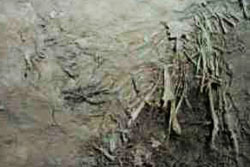 Sedge is also common in wet lowlands. The image to the right shows an example of sedge in found in the tunnel carbon-dated at 32,000 years old. It is an exceptional specimen because still contains chlorophyll making it green. Chlorophyll is a relatively fragile molecule (think about how long grass clippings stay green in a mulch pile.) In this case, the sedge collapsed into a melting ice wedge in late summer and froze before it could rot. The ice wedge was covered with enough collapsing soil that it never thawed out again—giving us a preserved green specimen.
Sedge is also common in wet lowlands. The image to the right shows an example of sedge in found in the tunnel carbon-dated at 32,000 years old. It is an exceptional specimen because still contains chlorophyll making it green. Chlorophyll is a relatively fragile molecule (think about how long grass clippings stay green in a mulch pile.) In this case, the sedge collapsed into a melting ice wedge in late summer and froze before it could rot. The ice wedge was covered with enough collapsing soil that it never thawed out again—giving us a preserved green specimen.
Also found in the permafrost tunnel are evidence of willow shrubs (common in wet lowlands), and birch and alder trees. Surprisingly, no evidence of black spruce, a very common conifer in Alaska today, was found in the tunnel. It turns out black spruce is a relative newcomer to Alaska, arriving only in the last last 7,000 to 9,000 years, but the youngest part of the permafrost tunnel, the entryway ceiling, is over 10,000 years old.